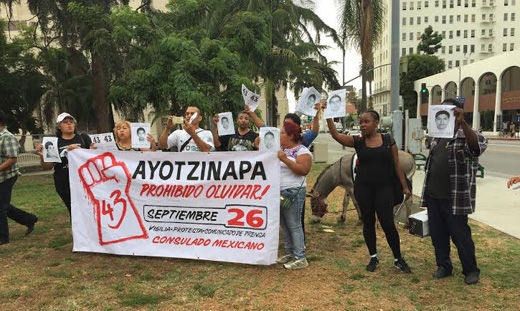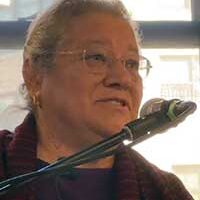
Many of us in the U.S. have wondered what is going on in Mexico. First we began to see the bodies of those whom the cartels were supposed to have killed. Then we heard rumors that there were suspicions of government involvement and connections with drug trafficking.
Several years later and now under a new presidency, on Sept. 26, 2014, students from the Ayotzinapa Rural Teacher’s College (near Iguala, in the Southern State of Guerrero) were violently attacked as they attempted to commandeer buses to take them home from a demonstration held in Mexico City. What had been an accepted practice of taking buses now was dangerous and deadly. Three students were killed and 43 disappeared.
One mother reported that she sat all day at a curbside in her village waiting for her son to return with others began coming home, but he never did.
Many have dedicated their time to search and demand that their sons be returned alive. “They were taken alive, we want them returned alive” is the call of families and their supporters.
The recent report by a team of five international experts, brought in by the Inter-American Commission on Human Rights (IACHR) to examine the case, has cleared up some speculation and disproved several versions that were being used to explain such an unexpected, violent turn of events.
The official government version was announced by the then-attorney general, Murillo Karam, who stated that the investigations had found the students were kidnapped by the police and had been turned over to a regional criminal gang, Guerreros Unidos (United Warriors), who killed them and burned their bodies, throwing the remains into the San Juan River in trash bags.
Another version circulated soon after the incident was that the Mayor of Iguala had ordered the police to stop the students because he did not want them to disrupt an event that his wife was holding. This was disproven by the many testimonies of surviving students.
The IACHR panel theorizes, based on an analysis of the written and oral evidence presented to them, that the students may have unknowingly commandeered buses carrying heroin or drug money. They cite that a fifth bus was not analyzed and barely mentioned in reports. When the commission requested more information they found many discrepancies causing speculation that a cover-up had taken place. The IACHR panel, when it tried to investigate further, was given pictures of a bus that did not coincide with eyewitness descriptions nor video footage of the bus on the day it left the station.
One conclusion of this investigation is that the police are not professionally trained to do a proper investigation. In addition to discrepancies, a great deal of information was never analyzed and key witnesses where never interviewed. Some people said they had been tortured to collaborate with the government version and officials never looked at other evidence which clearly contradicted some of those claims.
The government claimed that there were no military police present. It is clear, however, that the military did know of the violent attack and the detaining of the students but did nothing about it.
According to an article that appeared in the Huffington Post “several members of the 27th battalion told prosecutors in depositions that they were patrolling the streets of Iguala the night of the attacks and that they begun tracking the students hours before the first shots were fired. The reporters obtained the depositions using Mexican transparency laws after a months-long legal battle. The attorney general’s office redacted nearly all of the names of the interviewed military members.” A communication system called C4, used by the military on that night, made recordings to monitor the students throughout the nine violent events taking place on that 26th day in September of 2014, also proving that the military was present.
Lastly, the investigation showed that the 43 students were not burned in the dumps at the city of Cocula (a municipality in the Mexican state of Jalisco). The fire and smoke that such a burning would cause could not have gone unnoticed.
These 43 students are not the only ones that have disappeared; there are over 25,000 others, according to Mexican government reports. Over 100 bodies have been found in clandestine graves in and around Iguala. One would think that it was the effort of the Mexican Justice Department that found these bodies but in fact most have been located by family members, who were inspired by the parents of the 43 missing students, to brave the daily task of looking for their children some who have been missing since 2006.
They call their group the Committee In Search of the Other Disappeared of Iguala. They point to the hills calling them “the hills of cemeteries.”
The IACHR has asked to be allowed to continue their investigation for another six months, but with no word yet whether the Mexican government will agree.
There remain many unanswered questions; why were the students so brutally attacked when they were involved in an accepted practice of taking buses to transport them home from events/actions? What happened to them? Where are they? Who killed those that have been found in the clandestine graves since the attack? Why does Mexico have over 25,000 missing citizens?
There is speculation that the students were attacked as an attempt to stop them from speaking out against the government, because according to Vidulfo Rosales, a human rights activist and lawyer from the Tlachinollan Mountain Center for Human Rights, representing the Ayotzinapa students’ families, the students had been seriously questioning structural reforms. They would have become teachers and would have had direct connection with the community, educating people about how to defend themselves against injustice.
Cities throughout the world will be holding one-year anniversary events to continue the pressure for answers. In Los Angeles where I live, one such action will take place Saturday with a march starting at 2 p.m. at Olvera St. and ending at the office of the Consulate General of Mexico.
Photo: Rossana Cambron/PW










